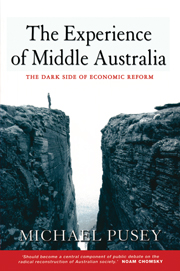Book contents
- Frontmatter
- Contents
- List of Illustrations
- Preface
- Abbreviations
- Chapter 1 The Experience of Economic Reform
- Chapter 2 Incomes and Their Meanings
- Chapter 3 Jobs, Work and Fairness in the Wake of Labour Market Reform
- Chapter 4 Working Families: Struggling with the Costs of Reform
- Chapter 5 Civil Society and Communities
- Chapter 6 Politics, Power and Institutions
- Chapter 7 Judgements on Economic Reform
- Appendix A Chronology of Economic Reform
- Appendix B Methods and Procedures: Middle Australia Project
- Appendix C Supplementary Tables
- Appendix D Income and Equivalent Household Income
- Notes
- Index
Appendix B - Methods and Procedures: Middle Australia Project
Published online by Cambridge University Press: 22 September 2009
- Frontmatter
- Contents
- List of Illustrations
- Preface
- Abbreviations
- Chapter 1 The Experience of Economic Reform
- Chapter 2 Incomes and Their Meanings
- Chapter 3 Jobs, Work and Fairness in the Wake of Labour Market Reform
- Chapter 4 Working Families: Struggling with the Costs of Reform
- Chapter 5 Civil Society and Communities
- Chapter 6 Politics, Power and Institutions
- Chapter 7 Judgements on Economic Reform
- Appendix A Chronology of Economic Reform
- Appendix B Methods and Procedures: Middle Australia Project
- Appendix C Supplementary Tables
- Appendix D Income and Equivalent Household Income
- Notes
- Index
Summary
The sample consists of 403 ‘middle Australians’ in five Australian capital cities: Sydney, Brisbane, Adelaide, Melbourne, and Canberra. The respondents were randomly selected from a sub-set of the 9483 ABS Collection Districts (CDs) used by R. Gregory and B. Hunter for their study of changes in income distributions in urban Australia from 1976 to 1991. The sub-set consists of CDs with average household incomes below the 90th percentile and above the 20th percentile. Indexed to year 2000 prices this represents an average household income cut off of $57,541 for the 90th percentile and $36,483 for the 20th.
Approximately one-third were selected from CDs in which household incomes had been rising steeply in the period from 1976 to 1991. ‘Rising steeply’ here means CDs in which average household income had risen over that period by more than one standard deviation from the mean overall change in household income. Conversely, another third of the sample were taken from CDs at the other end of the range, in which household income had been declining by more than one standard deviation. The steady group were taken from a like number of ‘middle’ CDs for which incomes had not risen or fallen more than 0.2 of a standard deviation on this criterion. Owing to an error, 53 cases were excluded from comparisons of perceptions among the three groups (rising, steady, falling).
Two-thirds of the respondents were located in Sydney for reasons of cost in recruiting and sending interviewers to other states.
- Type
- Chapter
- Information
- The Experience of Middle AustraliaThe Dark Side of Economic Reform, pp. 194 - 196Publisher: Cambridge University PressPrint publication year: 2003



